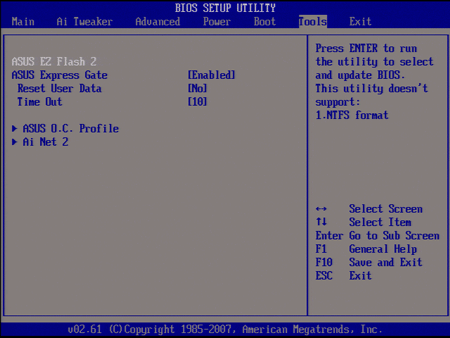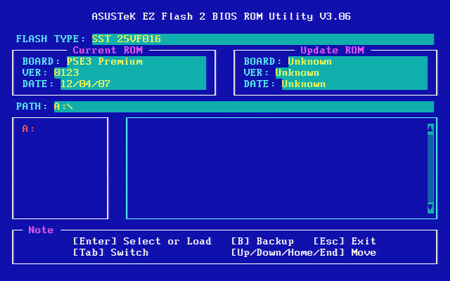X48 Motherboard Comparison
Additional BIOS Features
Asus includes three useful utilities for updating and saving BIOS firmware and custom settings.
Asus EZ Flash 2 allows you to flash the BIOS from either a floppy or USB flash drive, without the hassle of creating "bootable media". While a variety of companies, including Asus, also allow flashing the BIOS from within windows, EZ Flash 2 significantly reduces the risk of a "bad flash".
Two boxes below the "path" bar allow drive selection on the left side and file selection on the right. USB drives appear as "HDD-1" on the left side.
Though Asus didn't have any updates for the P5E Premium WiFi-AP @n Edition at press time, we checked the website for updates to another model to gauge the "user experience". We often find Asus' Taiwan site to be more up-to-date than its U.S. version, but both sites are usually very slow, taking up to two minutes to refresh a page. Once you've navigated to your motherboard model (assuming your browser didn't time out), clicking the "download" link in the upper-left corner takes you directly to the appropriate downloads page for the model you were viewing. The site is easy to use for anyone who has the patience of a tree sloth - analog modem users limited to 33k or slower connections can once again feel good about the speed of their local service...
The next interesting BIOS add-in is the Asus O.C. profile, which allows users to save custom BIOS settings for retrieval following any required "CLR_CMOS" operation. Overclockers who find they've taken their systems too far can easily return to a previously-saved configuration. Two profiles can be saved onto the BIOS ROM itself, while additional profiles can be transferred to a floppy or USB flash drive.
The ability to save overclocking profiles to a flash drive is a blessing to anyone who would like to transfer custom settings to an identical system, or share them with friends.
Accessories
| Accessories | |
|---|---|
| Documentation & Software | Motherboard ManualMotherboard Driver DVDChipset Fan Instructions |
| Hardware | 1x 80-conductor Ultra ATA cable1x Floppy Cable6x SATA Data Cable1x 4-pin to SATA power adapter (two-device)1x Port Breakout Plate (2x USB, 1x IEEE-1394)2x Heatpipe Cooling Fan (Supplemental)2x WiFi Antenna1x I/O Panel Shield1x Asus Q-Connector Kit |
The P5E3 Premium WiFi-AP @n Edition includes every cable needed to reach a full internal drive configuration, two WiFi antennas for its 802.11n wireless adapter, and two supplemental chipset/VRM cooling fans. The chipset/VRM sinks normally rely on CPU air cooler draft to function properly, and the supplemental fans are meant to restore the missing airflow whenever the P5E3 Premium WiFi-AP @n Edition is used in a liquid-cooled system.
Get Tom's Hardware's best news and in-depth reviews, straight to your inbox.
A full multi-language user's manual and driver/application DVD are also provided. The latter includes utilities such as ASUS PC Probe II, ASUS Update, ASUS AI Suite, Corel Snapfire Plus SE and Norton Internet Security.
Current page: Additional BIOS Features
Prev Page BIOS And Overclocking Next Page Gigabyte GA-X48-DQ6-
Help please.Can this board be configured with the first two (SATA) HDs mirrored and the other drives JBOD? Thank you in advance.Reply
-
oblivionspell Great review, very detailed and informative. But I must say that either you were lucky that your X38 P5E3 Deluxe came with a better-than-average chipset or that I wasn't so lucky and got a malfunctioning one.Reply
I have an Asus Maximus Formula which is, as you know, the Republic of Gamer's solution for the X38 and recently bought a Patriot Extreme Performance 1150mhz PC2-9600. Whenever I try anything above 1020mhz for the RAM my PC reboots; the higher it is the less time it takes to do it. At 1020mhz it'll only reboot if I run something more demanding like 3dMark06 or any new game, at 1100mhz it'll barely show the Windows loading screen then reboot, above 1120mhz it'll not even load windows and freeze. But in every case it boots up fine.
The Asus forums are full of users who can't get stability in any way with >=1066mhz ram on X38 boards. A selected few have come to accomplish it however, which leads me to think those were the lucky ones who got the good shipment, like you. The Patriot forums are the same, X38 users can't get their system stable with RAMS over 1066 or not even that.
Maybe that X48 "official" support is something to consider, it might be the fix to the X38 we users are looking for. Even if it's only to make sure it'll run RAMs at >=1066mhz, it's good enough already.
-
oblivionspell - Have you tried manually setting your RAM voltage to the correct value for the performance setting(s)?Reply
I had to do this on my Asus Crosshair, even though EPP is supposed to take care of it for you. Without manually setting the voltage, I had memory corruption and crashes, but could use the non-EPP mode. With the voltage bumped to the correct 2.1V,
the EPP modes work perfectly. -
Crashman oblivionspellGreat review, very detailed and informative. But I must say that either you were lucky that your X38 P5E3 Deluxe came with a better-than-average chipset or that I wasn't so lucky and got a malfunctioning one.I have an Asus Maximus Formula which is, as you know, the Republic of Gamer's solution for the X38 and recently bought a Patriot Extreme Performance 1150mhz PC2-9600. Whenever I try anything above 1020mhz for the RAM my PC reboots; the higher it is the less time it takes to do it. At 1020mhz it'll only reboot if I run something more demanding like 3dMark06 or any new game, at 1100mhz it'll barely show the Windows loading screen then reboot, above 1120mhz it'll not even load windows and freeze. But in every case it boots up fine.The Asus forums are full of users who can't get stability in any way with >=1066mhz ram on X38 boards. A selected few have come to accomplish it however, which leads me to think those were the lucky ones who got the good shipment, like you. The Patriot forums are the same, X38 users can't get their system stable with RAMS over 1066 or not even that.Maybe that X48 "official" support is something to consider, it might be the fix to the X38 we users are looking for. Even if it's only to make sure it'll run RAMs at >=1066mhz, it's good enough already.Reply
It's just a matter of having the right RAM and using the correct timings and voltage. All X38 and X48 motherboards that support DDR2 memory can run DDR2-1066 speeds with stability, so long as the RAM is set up right in BIOS. -
"Inside, users will find a GUI based on the Smart Common Input Method (SCIM) platform."Reply
This is not accurate. SCIM is an "input method" -- a scheme for entering internationalized text. Not sure what the GUI is really based on. GTK2, maybe? -
Crashman Reply"Inside, users will find a GUI based on the Smart Common Input Method (SCIM) platform."
This is not accurate. SCIM is an "input method" -- a scheme for entering internationalized text. Not sure what the GUI is really based on. GTK2, maybe?
I see your point, but that's the same arguement as "Windows 98SE is a GUI based on DOS". Which is innacurate only in wording. It would be better to say "Windows 98SE is a GUI for DOS".
So, you'd be happier to read "Users will find a GUI for the Smart Common Input Method (SCIM) platform" correct? -
chill70 It's not only the wording. SCIM is not an operating system, so even your example is not analogous (won't even mention that DOS and Windows are separate operating systems with distinct kernels, etc).Reply
This statement is as correct as saying Vista has a GUI based on a 105-key keyboard.
SCIM is an input method platform independent on the GUI. GTK GUI is an widget toolkit, independent on SCIM (although they *may* used each other). Neither is "based" on the other.
If you want to emphasize that the Express Gate supports users of many different languages and nationalities you can mention that the GUI USES SCIM.




